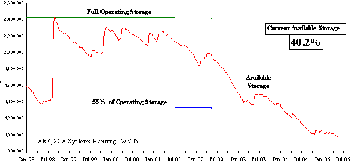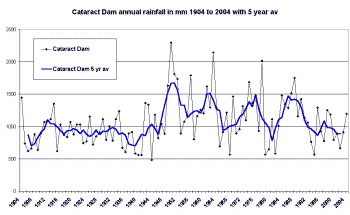
Andrew Mitchell's site packed with graphics and stats on Sydney water supply and dams.
http://www.iliveinsydney.com/water/damstats.php
 |
Graphic of dam levels
in Megalitres from Jan 98, Sydney Catchment Authority web site
http://www.sca.nsw.gov.au/dams/203.html A short history of
Sydney's water supply can be read at
http://www.sca.nsw.gov.au/dams/history.html and it is obvious that
droughts and periods of cyclic low rainfall have driven water
policy in NSW for over 150 years. In view of the obvious
realities of our rainfall history you would think water managers would
learn to plan future water supplies in periods of elevated rainfall. Andrew Mitchell's site packed with graphics and stats on Sydney water supply and dams. http://www.iliveinsydney.com/water/damstats.php |
 |
The
points I am making contrary to the general media hype is that
Sydney catchment rainfall is no lower than several previous periods eg
around
circa 1994, 1979-84, 1934-42, 1904-1910. The well quoted Tim Flannery (of "Perth will die" fame) is even referring to normal high rainfall events as "freak", to bolster his vision of ongoing drought. See Sydney rainfall page for more graphics. Policymakers must be very careful to separate fact from fiction in all this media frenzy or NSW taxpayers will be saddled with multi-$Billion desalination plants costs forever. More rainfall data will be posted as it comes to hand |
| Perth
Water Users sets out point by point how WA Govt mismanagement of Perth
water resources is at the root of our so called "water crisis". Perth Water Users (PWU) illustrated 6 May submission to the ERA Inquiry on Urban Water and Wastewater Pricing - can be read on pdf file at http://www.era.wa.gov.au/water/content/waterInquiry/default.cfm follow link under heading Submissions, to "Draft Report Submissions New!"; for our September 2004 3 page pdf submission click on "Issues Paper Submissions". |
Units Used to Specify Water Consumption and Storage
| One Gigalitre | = | one thousand Megalitres | |
| One Gigalitre | = | one million kilolitres | |
| One Megalitre | = | one thousand kilolitres | |
| One Megalitre | = | one million litres | |
| One kilolitre | = | one thousand litres | |
| One kilolitre of water | = | one thousand kilograms | = one tonne |